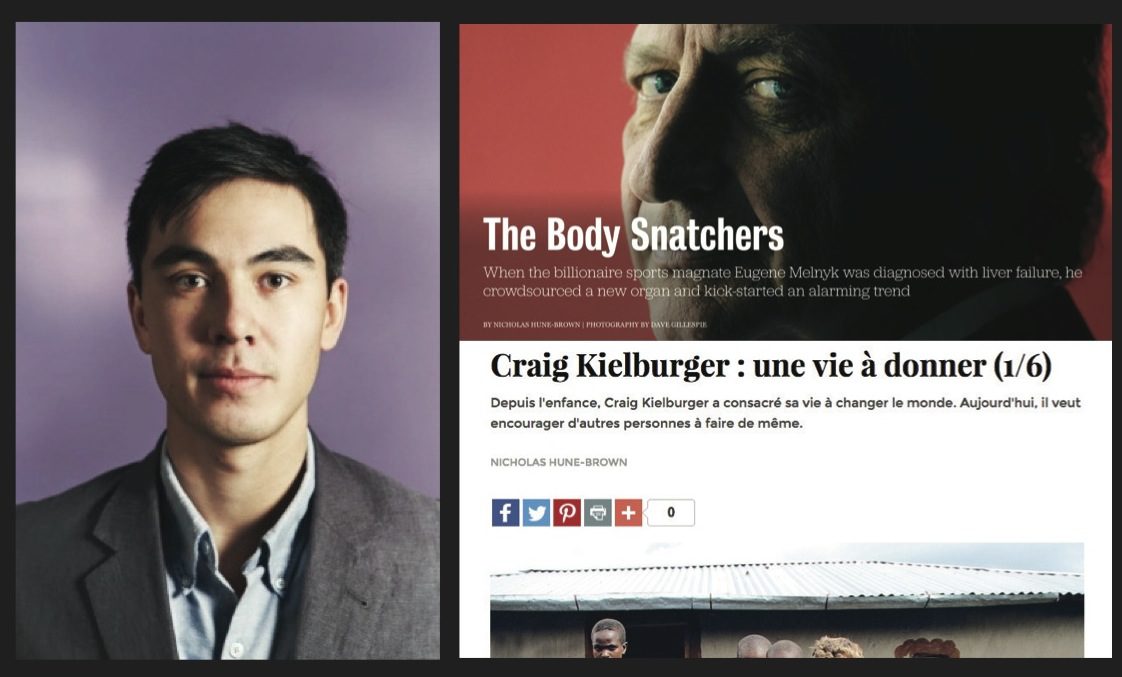A behind-the-scenes look at the NMA nominated work of Nicholas Hune-Brown
By Chris Lowrey
Nicholas Hune-Brown is a Toronto-based journalist who has been nominated more than a dozen times at the NMAs, which honour excellence in Canadian magazines. This year, he’s nominated for five, leading all individuals nominees—one in the Words and Pictures category, one in the Health and Medicine category, one in the Profile section and two in the Columns section. And even if you don’t know him from his many NMA nominations, you’ve probably seen his writing in Toronto Life, Hazlitt, Sharp, Reader’s Digest and The Walrus, among others.
Here are four things we learned about his nominated pieces from a conversation with Hune-Brown.
1. Billionaire sports magnates can be very candid
In one of Hune-Brown’s nominated pieces, “The Body Snatchers” for Toronto Life, he examines the role social media can play in a person’s search for an organ donor. He examined this phenomenon through the lens of Ottawa Senators owner Eugene Melnyk’s public appeal for a live liver donor. Melnyk’s decision, and the donors who subsequently came forward, lit off a firestorm on social media with several people questioning the ethics of his plea.
When Hune-Brown spoke to Melnyk, the Sens’ owner was still in the recovery stages of the transplant. Hune-Brown, having interviewed media savvy people before (more on that later), did not expect Melnyk to be as forthcoming as he was. “He’s incredibly candid in the interview,” Hune-Brown said. “Initially, I expected him to be a little cagier than that, especially for someone so high-profile.”
As a result, Hune-Brown got great quotes from Melnyk, including such chilling statements as, “If I didn’t go public, I’d die.”
Hune-Brown said that it was refreshing to speak to a person who is in the media regularly—especially someone in professional sports—and get more than just clichés.
2. Other high-profile people are not as candid as billionaire sports magnates
Another nominated piece for Hune-Brown is the Reader’s Digest piece, “One Life to Give.” It is a profile of the famous activist Craig Kielburger, who can frequently be seen going form campus to campus here in Canada in between his trips to Africa.
When Hune-Brown sat down for the interview with Kielburger, he only had about an hour with him. During this window, there was a photographer taking pictures and Kielburger’s public relations team kept a close eye on the interview.
“I could feel in my frantic 45 minutes with Kielburger, and the clock ticking down, I could hear him repeating stuff that I had already read online,” Hune-Brown said. “That’s a terrible feeling. I wasn’t fully successful in getting him off his lines.”
Hune-Brown said it’s understandable for someone like Kielburger to stick to his lines. After all, he probably gets asked the same question hundreds of times. But Hune-Brown found it tough to pierce through Kielburger’s armour. “How do you make that at all real or interesting?” he wonders.
Hune-Brown said he needs to do a better job of holding his subjects’ feet to the fire, or at least push them into more unfamiliar territory. “It’s something I still have to learn, I think,” he said. Ultimately, secondary sources played more of a role out of necessity. “This was a bit of a smaller profile but you want to speak with those people to get some sense of who the guy is,” Hune-Brown said. Although Hune-Brown is leery of leaning too hard on secondary sources, the people he spoke to helped the piece come together.
3. He writes a sports column based on the thesis that sports is meaningless
Hune-Brown writes a sports column called “The Reluctant Fanatic” for Sharp Magazine. It’s a sports column that examines bigger issues in the world of sports.
But because the column only appears once every couple of months, he can’t do a typical sports column. “Sports is something that is so current and quick-moving that, by nature, the column becomes something very different than what a sports column can be,” Hune-Brown said.
So instead of focussing on last night’s game, he’ll focus on a far larger issue, like the role of sports in nationalism. Other times, he’ll go hyper-specific with his story. Recently, Hune-Brown looked at the world of online gaming as a sporting event.
When he was first approached with the idea of writing a sports column, Hune-Brown was hesitant. “If you’d have asked me five years ago if I was ever going to be a sports columnist in a men’s magazine I definitely wouldn’t have thought that was a possibility,” he said. “I was a sports guy forever. Then in university and high school I thought it was lame and I should be liking art and smoking pot and doing all those things. Jocks seemed like my enemy at that point.”
At the end of the day, Hune-Brown doesn’t treat his sports columns like sports is the be-all and end-all to life as we know it, like so many other writers do. “The underlying thesis of the column is that sports are meaningless,” he said.
4. He avoids “crappy journalism” when writing about studies
“Studies Show,” in Hazlitt, is a column that uses scientific studies as jumping-off points about different topics. “I would think about very broad ideas, like, maybe I wanted to write about shame or something,” Hune-Brown said. “So I would look through a bunch of studies and see if there was anything interesting that illuminated that.”
However, writing about scientific studies can be a lazy way to get an easy 500-word count.
“I try not to do the crappy journalism thing where you take a study and, from that, extrapolate a much bigger truth, because that’s one of my least-favourite genres of journalism: people overblowing inconsequential studies,” Hune-Brown said.
Instead, Hune-Brown tries to inject a personal anecdote or recent news story that works with his topic. In this sense, his columns are a little bit more playful than others that examine scientific studies. “It was never a straight up ‘chocolate cures cancer,’ kind of digestive,” he said.
Chris Lowrey recently completed a field placement at the Ottawa Citizen and is a graduate of Algonquin College’s journalism program.
Chris Lowrey recently completed a field placement at the Ottawa Citizen and is a graduate of Algonquin College’s journalism program.


